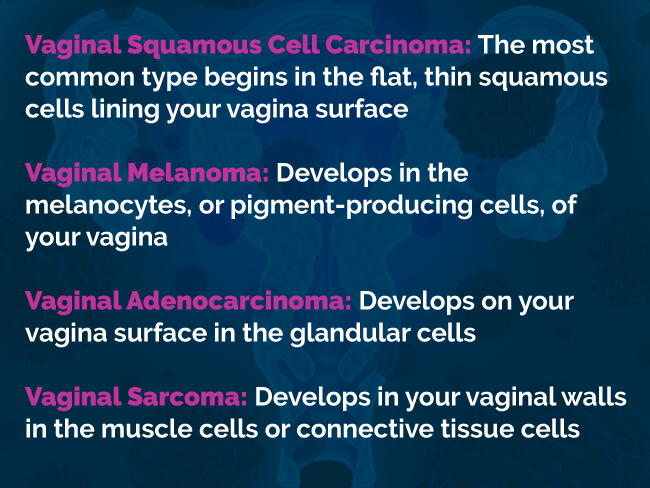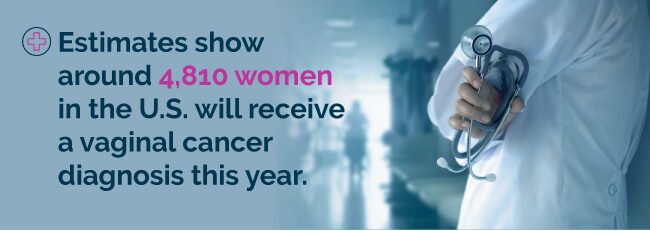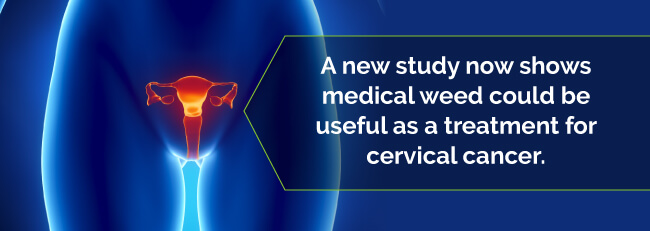
Nearly every state approving medical cannabis allows its use for patients with cancer. Marijuana can help you ease nausea, thwart pain, boost your mood, fight depression, increase your appetite and so much more. It’s easy to see why so many patients turn to its powerful potential. Like other types of cancer, patients suffering from vaginal cancer can also benefit from the medicinal effects of cannabis.
Vaginal cancer is a rare form of cancer women can develop that typically occurs in the cells lining your vaginal surface. Vaginal malignant diseases are either primary or metastatic vaginal cancers from distant or adjacent organs. Primary vaginal cancers are not involved with the vulva distally or external cervical proximally — they occur strictly in the vagina.
Exposure to the drug diethylstilbestrol (DES) and your age — usually 60 or over — are two factors that increase your risk of contracting vaginal cancer. Other risks include having:
The type of vaginal cancer you have depends on the cells where your cancer started. The four main types of vaginal cancer include:

Alexander Brunschwig released the initial cases of pelvic exenteration in 1946. Five of 22 surgical patients in his first series died from this radical surgery that removes all pelvic cavity organs. The initial procedure composed of connecting the colostomy to the ureters. Bricker, in 1950, modified the operation after various other changes improved the its outcome. Today, with continent vesicostomy and vaginal reconstruction, pelvic exenteration is an acceptable surgical treatment in some instances.
You may not notice any symptoms of early vaginal cancer. However, once it progresses, you might begin experiencing symptoms such as:
Consult with your physician if you’re experiencing any of these or other vaginal cancer-related symptoms. Since there aren’t always symptoms of vaginal cancer at first, you should continue to have regular pelvic exams.

Vaginal cancer, like cervical cancer, affects your sex organs, which can be uncomfortable or difficult to talk about. Often, people with cancers like penile, vulvar and vaginal cancers may feel embarrassed when talking about these private areas of their bodies.
But this shouldn’t deter you from getting the emotional support you need. Your healthcare team understands your embarrassment and will make it more comfortable for you to talk with them about it.
If your vaginal cancer links to HPV, you may feel like you don’t deserve help or support from loved ones or other people. You may believe they think it was your behavior that caused your cancer. Even though HPV can increase your risk of vaginal cancer, it doesn’t mean it caused the condition, and most genital HPV infections don’t lead to cancer. Vaginal cancer may affect any woman, regardless of her sexual history.
Living with this feeling of shame can make you feel:
When feeling alone in all this, it can lead to anxiety and depression. If you’re affected by these types of feelings, you should tell your healthcare team. There are resources available to you when you’re living with vaginal cancer. Your doctor can also point you in the direction of helpful support groups, one-on-one counseling, medication or medical marijuana recommendations.
Vaginal cancer statistics reported by American Society of Clinical Oncology (ASCO) with support from Conquer Cancer Foundation include:

The best treatment for vaginal cancer is prevention. However, there’s no sure way to prevent this disease. You can, however, reduce your risk if you undergo routine PAP tests and pelvic exams.
The treatment you receive for your vaginal cancer revolves around specific factors, including the type and stage of your vaginal cancer. Work closely with your doctor to decide on the best treatment plan for you based on your side effects and goals. Here are four treatment methods available for patients with vaginal cancer.
The most common types of surgery to treat vaginal cancer include:
If the surgeon completely removes your vagina, you may wish to undergo another surgery where they construct a new vagina. In this procedure, your surgeon forms a new vagina from different areas of your body like sections of intestine, pieces of skin or flaps of muscle.
The type of surgery dictates many of the side effects you’ll likely experience after surgery. Typically, the less complex the operation, the fewer side effects you will experience. Any surgery, no matter what type, can cause instant side effects, particularly pain. You may also experience blood clots or infection.
If the surgeon removed your lower vagina, you may have scar tissue form. Some women have bowel or bladder problems after their vaginal cancer surgery. You may experience a reduced sexual drive, trouble reaching orgasm or less pleasure during sexual intercourse.
Surgeons use high-powered energy beams like protons and X-rays during radiation therapy to kill cancer cells. There are two ways they deliver radiation:
Radiation therapy kills growing cancerous cells quickly, but can damage healthy cells nearby, too, which leads to side effects. The side effects you’ll experience from radiation hinge on the intensity and location of the treatment. Potential side effects may include:
If radiation and surgery aren’t able to control your vaginal cancer, your doctor may recommend other treatments, including chemotherapy. During chemo, the use of certain medications kills your cancer cells. Since it’s not clear if chemo is an optimal treatment for vaginal cancer, it’s typically not used by itself to treat vaginal cancer. However, it can be combined with other treatments, like radiation therapy, to improve the effectiveness.
As the chemo wipes out growing cancer cells, it also damages healthy cells. This damage to your healthy cells may lead to other side effects, like infection or fatigue. Chemo may also damage mucous membrane cells, such as those inside your throat, mouth, stomach and other areas throughout your body.
As a result, you may develop mouth sores and digestive system problems, such as diarrhea. Cell damage to the roots of your hair or follicles could result in hair loss. Of course, not everyone reacts to chemotherapy the same way.
This option is your last-case scenario. For patients who aren’t responding to surgery, radiation or chemotherapy, doctors can use clinical trials to experiment with new methods of treatment. Clinical trials may give you the opportunity to try advanced treatments for vagina cancer, but there’s no guarantee they’ll cure you.
Because having pre-cancer, uterine or cervical cancer increases your risk of vaginal squamous cell cancer, marijuana treatment would most likely work the same way for vaginal cancer as it does cervical or uterine.
As with many cancers, medical cannabis for vaginal cancer may have a positive effect on the reproduction and behavior of cancer cells in the vagina. Marijuana’s cannabinoids slow vaginal cancer cell reproduction to where the cells can’t reproduce and end up dying without spreading.
Patients can use cannabis oils specially made by doctors and scientists for patients for this process — you take the oil orally. Cannabis oil is rapidly becoming popular in cancer treatment because it may help eliminate dangerous cells from a cancer patient’s body.

One new study now shows medical weed could be useful as a treatment for cervical cancer. Through petri dish/test tube or in vitro, analysis, researchers from South Africa found cannabidiol (CBD) the non-psychotropic cannabinoid could offer anticarcinogenic properties. The researchers claimed the cannabis, through a cell death process known as apoptosis, acted on the cancer cells inhibiting their growth and causing them to kill themselves. While cervical and vaginal cancer are separate conditions, they are very similar.
Another study coming from the journal of Current Clinical Pharmacology showed medical pot reduces inflammation and serves as a preventative agent. Researchers believed this could also reduce the likelihood of cancer.
Many people find cannabis and vaginal cancer treatment effectively eases chemotherapy’s debilitating side effects. The main symptoms marijuana can quell include:
Marijuana for vaginal cancer can also:
As you’ll see through information provided by the National Cancer Institute, THC is the primary active cannabinoid, but CBD in weed helps to relieve pain, reduce inflammation and decrease anxiety without giving you the “high” that comes from THC.

There are psychoactive cannabinoids in marijuana for vaginal cancer, which means they act on your brain and can alter your mood. They also help to provide clinical relief for nausea and vomiting, pain, loss of appetite, depression and anxiety, along with helping to relieve side effects of cancer treatments.
There is an entire range of strains to choose from, each designed with the proper cannabinoids to relieve your specific symptoms, fight the disease and soothe its treatment’s side effects to give you a better quality of life.
Strains you may wish to experiment with to treat your vaginal cancer symptoms and treatment side effects include:
Speak to your medical marijuana doctor or budtender to learn more about these strains or others that may help you deal with your vaginal cancer treatment side effects.
Although patients with cancer often reach out for edibles, CBD oil and other potent concentrates, most go with vaporizing or smoking medical marijuana for vaginal cancer. Internal suppositories are suitable for vaginal cancer and help absorb active substances close to the affected area.
If you’re struggling with vaginal cancer, you could qualify for a medical marijuana card — check with your state’s health department to be sure. Once you believe you qualify, set up an appointment for an exam and consultation with a medical professional who is licensed to approve your disease. If you meet their requirements, they’ll recommend you for a medical marijuana card. Once you receive it, you can start relieving your debilitating cancer symptoms and treatment side effects right away.
To get this process started, use our database to search for a medical marijuana doctor and find a cannabis dispensary near you today.
Find A Doctor Find A Dispensary